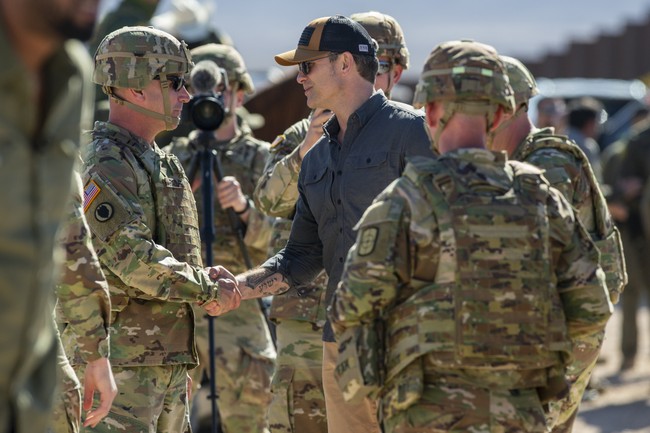From PJMedia.com

As a newly minted E-3 back in 1985, I had completed basic training, law enforcement school, combat, and weapons training at Camp Bullis, Texas, and was settled in with my new bride at a stateside assignment. Soon after we welcomed our first child, I was selected to hop on a C-130 cargo aircraft and deploy to the Nevada desert for desert warfare training.
Advertisement
Which was fine by me. I had signed up to do what the nation needed me to do, after all. Then came the news that I would forfeit something called BAS while I was deployed.
“What’s a Bass?” I asked a master sergeant whose name escapes me.
“It’s called a Basic Allowance for Subsistence,” he answered.
“You mean food?” I asked.
“Yep.”
I asked for clarification, at which point he explained that since I didn’t yet qualify for base housing for my family — due to my low rank — I was given an allowance for food while living off base, see? But since I would be deployed and receive sumptuous government-issued MRE (Meals Ready to Eat, or Meals Rejected by Ethiopians, as we called them), I would not be receiving this allowance while deployed.
“So I’m getting a pay cut for learning how to live like an animal in the desert?” I asked incredulously. The master sergeant explained that the food allowance was meant for me alone. I confessed that “I cheat and feed my family anyway.” But as usual, the lowest ranks tend to be at the bottom of that proverbial hill down which a certain rubbish rolls.
As irritating and challenging as that little experience was, there was no doubt that as the Air Force’s grunts, we were sufficiently fed to conduct the training and perform the mission. That was never in doubt. But according to writer and veteran Mike McDaniel, the issue of adequately feeding the troops has been an open question lately.
Advertisement
A week before President Trump was inaugurated, I interviewed Mr. McDaniel on my podcast and he explained that at one point recently, the Army had only two of its 11 chow halls open at Fort Hood. Indeed, one soldier posted a photo of his dinner at the chow hall on Fort Carson, showing a half of a piece of toast and a helping of lima beans.
During our interview, Mr. McDaniel and I both recounted our own experience as young troops, during which chow halls were open whenever the troops needed them and there was more than enough food for everyone. Alas, this has not been the case lately.
To make matters worse, a Military.com investigation reveals that of the $225 million collected from soldiers (much as was collected from me decades earlier), some $151 million of that money was sent elsewhere. Where exactly? According to an unnamed official, “It’s just returned to the big pool of funds, and it’s used someplace else.” According to writer Steve Beynon, at Military.com:
It’s unclear what specifically the additional funds taken from soldiers are being spent on, but they do not appear to be going toward feeding soldiers. Major expenses such as dining hall infrastructure and food service worker salaries come from separate funding sources and, when pressed repeatedly by Military.com, Army officials declined to provide additional financial data.
Advertisement
In military parlance, it’s called the “Tooth to Tail Ratio.” Historian John McGrath describes it as, “[T]he contrast between fighters (combat troops) and support or logistical troops.” It can be a fairly complicated formula since the line delineating those in support functions (the tail) and those at the pointy end of business (the teeth) is not always clear. One indicator, however, could be a look at the officer-to-enlisted ratio over the years. As Ben Wolfgang at The Washington Times noted:
By historical standards, the World War II era offers the starkest contrast with today’s figures. During the war, the military had about 2,000 generals and flag officers in a total force of roughly 12 million, a ratio of about 1 general or admiral for every 6,000 troops. Today’s figure is closer to 1 officer for every 1,400 troops, said Marine Corps Col. Gregory McCarthy, who penned a 2017 report for the National Defense University’s Joint Force Quarterly and described the transformation as “rank creep.”
With a ratio of one general to 6,000 troops, America defeated the Axis powers on the beaches of Normandy and throughout Europe, freeing the survivors of the Holocaust while also defeating Japan in the Pacific Theatre, which included bloody and costly battles both at sea and at places like Iwo Jima. Today, with a ratio of one general to 1,400 troops, we struggle to even adequately feed the troops.
Advertisement
“The actual count of generals or admirals hasn’t gone up that much. What has gone up is the ratio of these senior guys to the troops,” observed retired General Tom Spoehr, adding that “The reason that happened, by and large, is because we cut the forces, not because we grew a bunch of generals.”
As Secretary of Defense Pete Hegseth and the DOGE team examine DOD’s overall health, they could make significant strides toward restoring a “Warrior Mentality” at the Pentagon simply by making sure the troops are well-fed and superbly trained. As the old saying goes, “An army marches on its stomach.”
All articles possibly rephrased by InfoArmed.com
